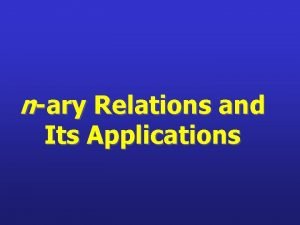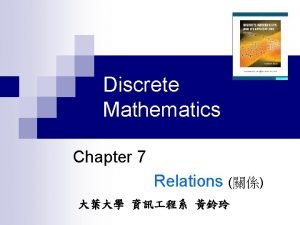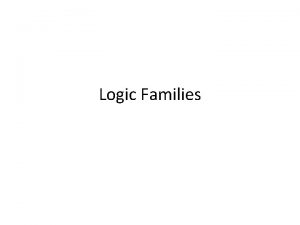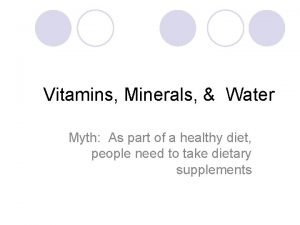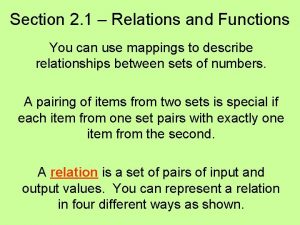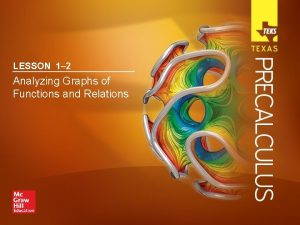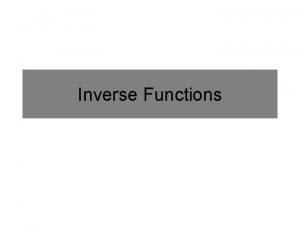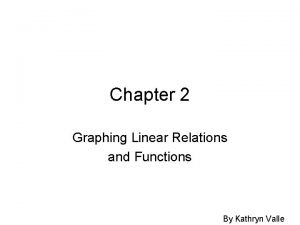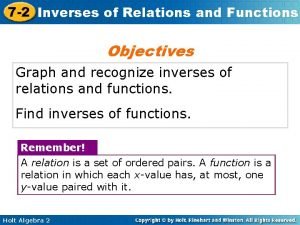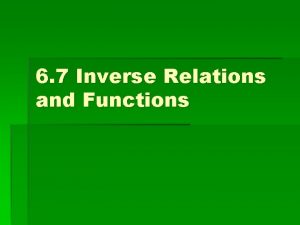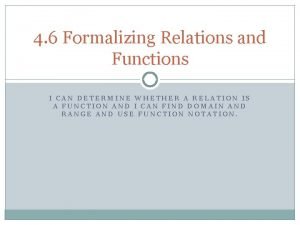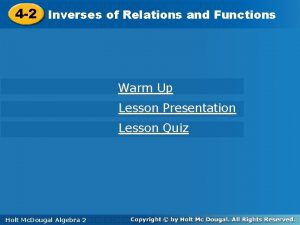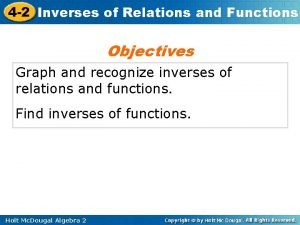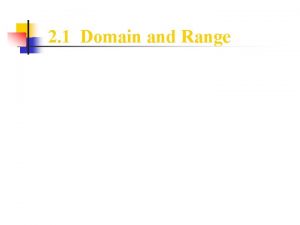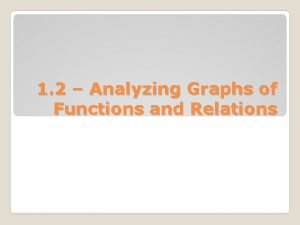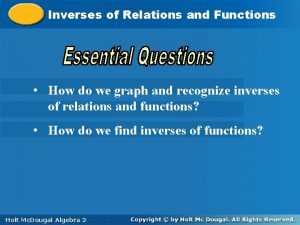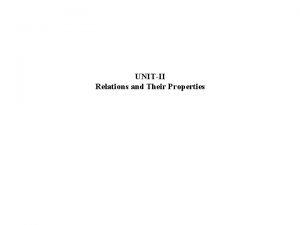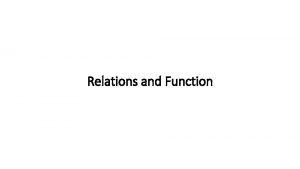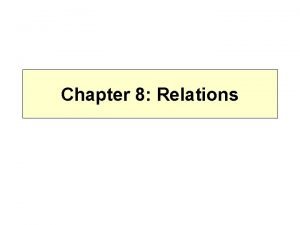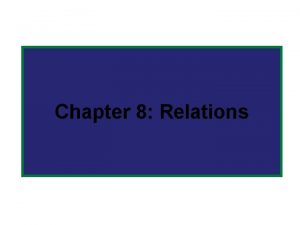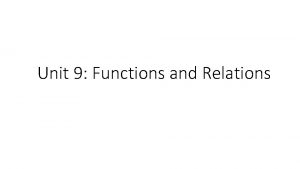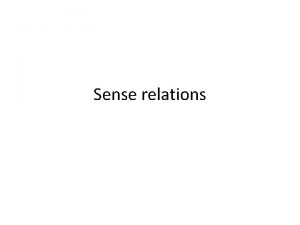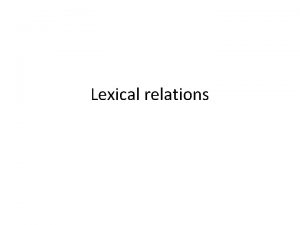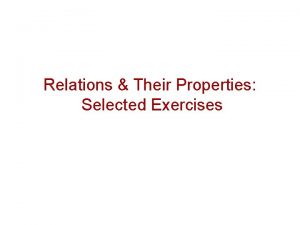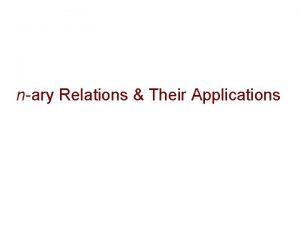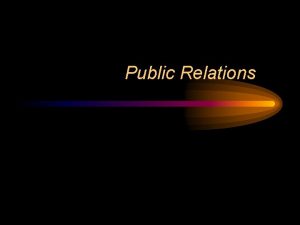Ch 8 Relations 8 1 Relations and their




























- Slides: 28

Ch. 8: Relations 8. 1 Relations and their Properties

Functions Recall ch. 1: Functions Def. of Function: f: A→B assigns a unique element of B to each element of A

Functions- Examples and Non. Examples Ex: students and grades

Function Ex Ex: A={1, 2, 3, 4, 5, 6}, B={a, b, c, d, e, f} {(1, a), (2, c), (3, b), (4, f), (5, b), (6, c)} is a subset of Ax. B Also show graphical format.

Relations are also subsets of Ax. B, without the above uniqueness requirement of functions. Def. of Relations: Let A and B be sets. A binary relation from A to B is a subset of Ax. B. Special Case: A relation on the set A is a relation from A to A.

Examples of relations • Flights

Review of Ax. B • Recall that Ax. B={(a, b)|a � A and b � B} • For A={1, 2, 3} and B={x, y}, find Ax. B • Find Ax. A

Functions and Relations • Do a few examples of students and grades and determine if they are functions and/or relations

Notations for Relations Notations: • Graphical • Tabular • Ordered pairs • a. Rb • later: matrices and digraphs

Properties for a relation A relation R on a set A is called: • reflexive if (a, a) � R for every a � A • symmetric if (b, a) � R whenever (a, b) � R for a, b � A • antisymmetric : (a, b) � R and (b, a) � R only if a=b for a, b � A • transitive if whenever (a, b) � R and (b, c) � R, then (a, c) � R for a, b, c � A

Alternative notation A relation R on a set A is called: • • reflexive if a. Ra for every a � A symmetric if b. Ra whenever a. Rb for every a, b � A antisymmetric : a. Rb and b. Ra only if a=b for a, b � A transitive if whenever a. Rb and b. Rc, then a. Rc for every a, b, c � A

Question • What does RST show? • RAT?

Ex: Consider the following relations R on the set A of all people. Determine which properties (RSAT) hold: 1. R={(a, b)| a is older than b } circle if so: 2. R={(a, b)| a lives within 10 miles of b } RSAT 3. R={(a, b)| a is a cousin of b } RSAT 4. R={(a, b)| a has the same last name as b } RSAT

More examples- R on the set A of all people. 5. R={(a, b)| a’s last name starts with the same letter as b’s } R S A T 6. R={(a, b)| a is a (full) sister of b } R S A T

Let A=set of subsets of a nonempty set 7. R={(a, b)| a is a subset of b } R S A T

Let A={1, 2, 3, 4} 8. R={(a, b)| a divides b } R={(1, 1), (1, 2), (1, 3), (1, 4), (2, 2), …} R S A T 9. R={(1, 1), (1, 2), (1, 4), (2, 1), (2, 2), (3, 3), (4, 1), (4, 4)} R S A T

Let A=Z (integers) 10. R={(a, b)| a≤ b } R S A T 11. R={(a, b)| a=b+1 } R S A T 12. R={(1, 1), (2, 2), (3, 3) } R S A T

Number of relations-questions How many relations are there on a set with 4 elements? Ax. A has ___ elements. So number of subsets is ___ How many relations are there on a set with n elements? ___ Number of reflexive relations on a set with n elements • The other ___may or may not be in. • So ___ reflexive relations.

Number of relations- Answers How many relations are there on a set with 4 elements? Ax. A has 4^2=16 elements. So number of subsets is 216 How many relations are there on a set with n elements? 2 n^2 Number of reflexive relations on a set with n elements • The other n(n-1) may or may not be in. • So 2 n(n-1) reflexive relations.

Combining Relations Ex: sets A={1, 2, 3}, B={1, 2, 3, 4}; Relations: R={(1, 1), (2, 2), (3, 3)}, S={(1, 1), (1, 2), (1, 3), (1, 4)} R∩S R� S R – S S – R

Def. of Composite Let R be a relations from A to B and S a relations from B to C. The composite of R and S: S ο R = {(a, c)| a � A, c �C, and there exists b � B such that (a, b) � R and (b, c) � S}

Composite example Ex 1: R from {0, 1, 2, 3, 4} to {0, 1, 2, 3, 4}, S from {0, 1, 2, 3, 4} to {0, 1, 2, 3, 4} R={(1, 0), (1, 1), (2, 2), (3, 0), (3, 1)} S={(1, 0), (2, 0), (3, 1), (3, 2), (4, 1)} Find S ο R Find R ο S

Ex 2 Ex. 2: R and S on the set of all people: Let R={(a, b)| a is the mother of b} S={(a, b)|a is the spouse of b} Find S ο R Find R ο S

Def of powers Def: Let R be a relation on the set A. The powers Rn, n=1, 2, 3, … are defined inductively by R 1=R and Rn+1=Rn R

Ex Ex: R={(1, 1), (2, 1), (3, 2), (4, 3)} R 2= {(1, 1), (2, 1), (3, 1), (4, 2)} R 3=… Show R 4=R 3 So Rn=R 3 for n=4, . .

Ex: R={(1, 1), (1, 2), (3, 4), (4, 5), (3, 5)} R 2 = {(1, 1), (1, 2), (3, 5)} R 3={(1, 1), (1, 2)} R 4=R 3 so Rn=R 3

Thm. 1 Theorem 1: Let R be a transitive relation on a set A. Then Rn is a subset of R for n=1, 2, 3, … Proof— what method would work well?

Proof By Induction: N=1: trivially true Inductive Step: Assume Rn � R where n� Z+. Show: _______ Assume (a, b) � R n+1. (Question: Show? ____) Then, since R n+1 = R n ο R, _______ Since ______, then ____ � R. Since _______ then ______ � R.
 N-ary relations and their applications
N-ary relations and their applications Relations and their properties
Relations and their properties Relations and their properties
Relations and their properties Discrete presentation
Discrete presentation Employee relations in public relations
Employee relations in public relations And the continuance of their parents' rage translation
And the continuance of their parents' rage translation Characteristics of ttl logic family
Characteristics of ttl logic family What makes material useful and harmful
What makes material useful and harmful Cardinal virtues and theological virtues
Cardinal virtues and theological virtues What are vitamins functions
What are vitamins functions Functions of vitamins
Functions of vitamins Relations and functions
Relations and functions Chapter 10 racial and ethnic relations
Chapter 10 racial and ethnic relations Analyzing graphs of functions and relations worksheet
Analyzing graphs of functions and relations worksheet Domain and range of tan function
Domain and range of tan function Public relations strengths and weaknesses
Public relations strengths and weaknesses 2-2 linear relations and functions answers
2-2 linear relations and functions answers Public relations advantages and disadvantages
Public relations advantages and disadvantages Sales promotion and public relations
Sales promotion and public relations Chapter 10 racial and ethnic relations
Chapter 10 racial and ethnic relations 7-2 inverses of relations and functions
7-2 inverses of relations and functions 6-7 inverse relations and functions
6-7 inverse relations and functions Formalizing relations and functions
Formalizing relations and functions 4-2 inverses of relations and functions
4-2 inverses of relations and functions 4-2 inverses of relations and functions
4-2 inverses of relations and functions Domain and range of relation
Domain and range of relation Analyzing graphs of functions
Analyzing graphs of functions Produk kartesius
Produk kartesius 4-2 practice b inverses of relations and functions
4-2 practice b inverses of relations and functions
